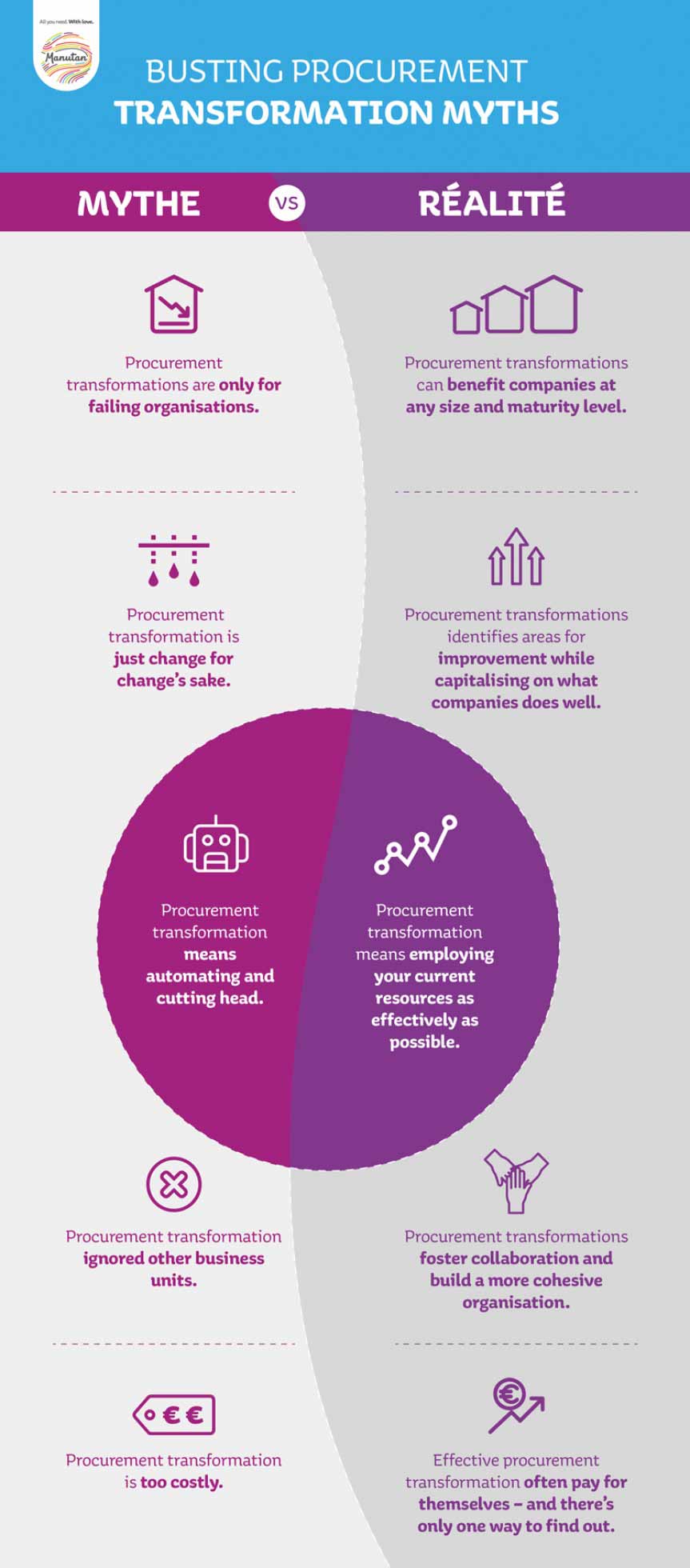All too often, the digital transformation of procurement is still seen as something that is confined to the procurement field. Indeed, a series of tenacious clichés sometimes prevent decision-makers from seeing the strategic importance to the company of the digital transformation of procurement.
This means the work to educate people about procurement must continue. Having put to rest six misconceptions about the remit and operation of the procurement department, in this article we turn our attention to five clichés regarding its digital transformation.
Companies can improve by stamping out the five most common clichés regarding the digital transformation of procurement departments:
- "The digital transformation of procurement is only for firms in difficulty"
- "The digital transformation of procurement is merely a cosmetic change"
- "The digital transformation of procurement is synonymous with automation and redundancies"
- "The digital transformation of procurement ignores other departments"
- "The digital transformation of procurement is too expensive"

The digital transformation of procurement benefits all companies
There is no question that digitalisation of its procurement department can significantly improve the competitiveness of a company running headlong into the wind, so the potential benefits of the transformation actually apply whatever the situation.
It is also likely that carrying out the digital transformation of the procurement department in a calmer environment will contribute to its success. Basically, teams are more receptive and the schedule is less rigid.
The key issue, in order to reap all the benefits of the digital transformation of procurement, is the quality of the project management. We need to know:
- What are the objectives?
- How is it governed?
- What are the tools?
The answers to these three questions are key to the outcome and the true impact of the transformation of procurement. For any company!
The digital transformation of procurement capitalises on the company's strengths
Each company carries out its business in its own unique way. Its history, the skills accumulated by its teams and its location, for example, have forged a singular know-how that makes its products or services unique.
Far from being a change of face, the digital transformation of procurement is rooted in this singularity. Enabling the collection and sharing of a volume of data disproportionate with the capacity of less advanced organisations, digitalisation and so-called big data reinforce the company's strengths on three levels:
- The transmission of knowledge, which is precious in this time of mass retirements.
- The alignment of practices, with the idea that best practices are spread more easily and ergonomically.
- The speed of information transmission, through the mobility of tools and the capacity, for example, to manage validation workflows.
The digital transformation of procurement optimises resources
What does the transformation of procurement actually involve? The common cliché is automation and therefore redundancies.
Although digital transformation does rely partly on automation for efficiency, this automation relates to time-consuming, repetitive tasks, and generally without much added-value.
For example, automating the verification of invoices and avoiding data re-entry frees up time for the procurement teams. But most importantly, the time and energy made available can be invested in relationships:
- Relationships with suppliers and partners
- Relationships with other company departments
- Relationships with strategic decision-makers
Digitisation of the procurement department transforms the nature of jobs rather than eradicating them.
The digital transformation of procurement promotes collaboration and solidarity
Transforming the procurement department into a better business partner is based on an open approach to relationships within the company. Therefore, the impetus provided by the procurement department advances collective intelligence and cohesion throughout the organisation.
The procurement department is at its best when it engages in regular, in-depth and balanced discussions with departments such as production, R&D, development and marketing, as well as the quality and finance departments.
The digital transformation of procurement saves the company money
Transforming the procurement department offers the potential for lower prices through improved management of data, such as seasonal variables, logistical variables or quantitative variables.
But the true benefit lies elsewhere. It resides in a better understanding of the needs of the business according to three criteria:
- The quest for valuable innovations
- Control of supplier risks, including ethical risks
- The sustainability of the supplier relationship and the strengthening of co-operation within a united ecosystem
It should be added that the digital transformation of procurement provides the department with a data analysis and simulation capability that better documents the strategic decision-making of the company. The procurement department's enhanced contribution to the company's strategic planning is also the result of its digital transformation.
In conclusion, the digital transformation of procurement is not a desperate bid to escape a bad situation, nor is it a fantasy of the Director of Procurement, nor a cost to the company. The digitalisation of procurement is an investment that strengthens the company's assets and benefits all of its departments. It also gives procurement teams the opportunity to enrich their roles and leads to better cohesion within the organisation.
If this article has changed your initial perception of the digital transformation of procurement, perhaps you will now consider such a project within your own organisation.
Before embarking on the digital transformation of your own procurement department, take a look at the article "The P2P roadmap" by Xavier Laurent, Manutan's Director of Value-Added Services.








